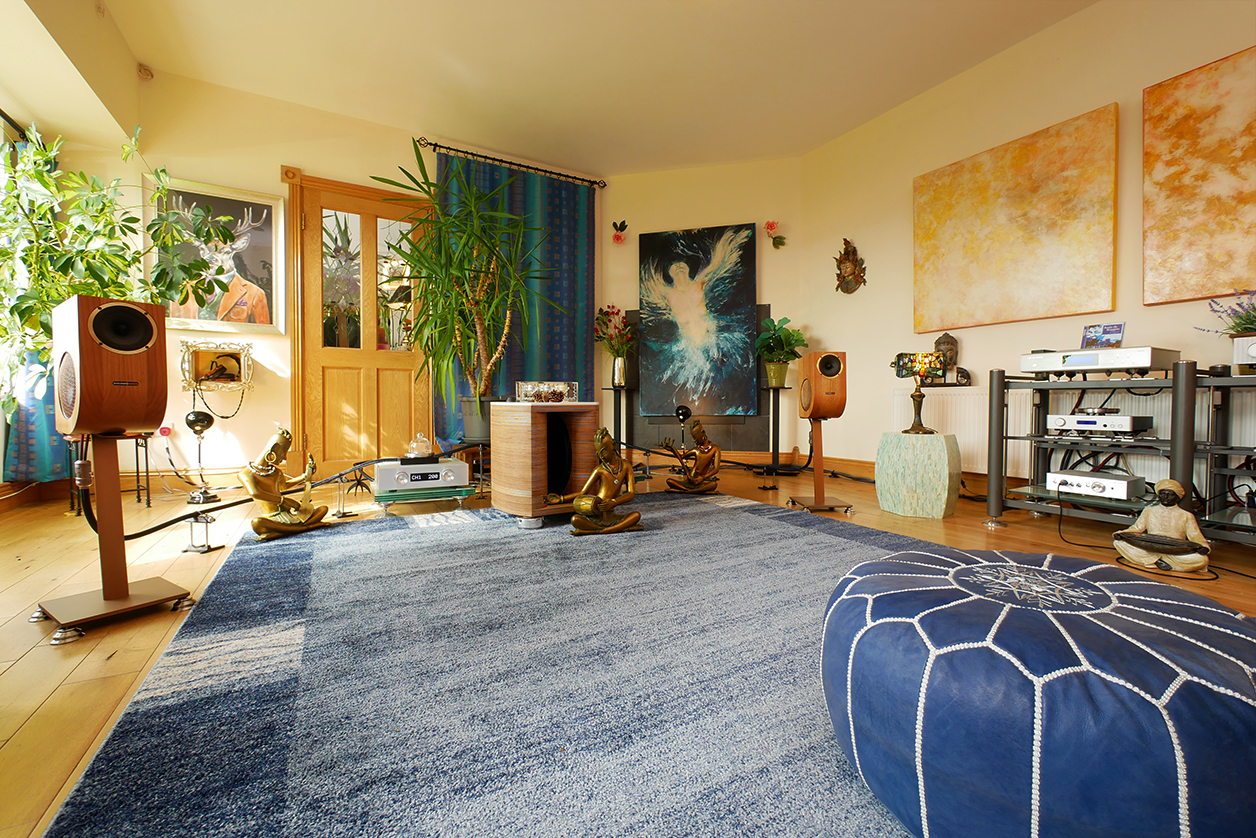
Country of Origin

Reviewer: Srajan Ebaen
Financial interests: click here
Main system: Sources: Retina 5K 27" iMac (4GHz quad-core with Turbo, 32GB RAM, 3TB FusionDrive, OSX Yosemite. iTunes 14.4), PureMusic 3.02, Audirvana 3, Qobuz, Tidal, Singxer SU-6 USB bridge, Sonnet Pasithea DAC; Active filter: icOn 80Hz/4th-order hi/lo-pass; Power amplifiers: Kinki Studio EX-B7 mono, Enleum AMP-23R; Headamp: Kinki Studio; Phones: HifiMan Susvara; Loudspeakers: sound|kaos Vox 3awf w. sound|kaos DSUB 15 on Carbide Audio footers, Audio Physic Codex, Cube Audio Nenuphar Cables: Complete loom of Allnic Audio ZL; Power delivery: Vibex Granada/Alhambra on all source components, Vibex One 11R on amps, Furutech DPS-4.1 between wall and conditioners; Equipment rack: Artesanía Audio Exoteryc double-wide 3-tier with optional glass shelves, Exoteryc Krion and glass amp stands; Sundry accessories: Acoustic System resonators, LessLoss Firewall for loudspeakers, Furutech NCF Signal Boosters; Room: 6 x 8m with open door behind listening seat
2nd system: Source: Soundaware D300Ref SD transport clock-slaved to Denafrips Terminator +; Preamp/filter: icOn 4Pro + 4th-order/40Hz hi-low pass; Amplifier: Goldmund Job 225; Loudspeakers: Acelec Model One, Dynaudio S18 sub; Power delivery: Furutech GTO 2D NCF; Equipment rack: Hifistay Mythology Transform X-Frame [on extended loan]; Sundry accessories: Audioquest Fog Lifters; Furutech NFC Clear Lines; Room: ~3.5 x 8m
Desktop system: Source: HP Z230 work station Win10/64; USB bridge: Singxer SU-2; Headamp/DAC: iFi iDSD Pro Signature; Headphones: Final D-8000; Active speakers: DMAX SC5
Upstairs headfi/speaker system: Source: smsl Dp5 transport; DAC: Auralic Vega; Integrated amplifier: Schiit Jotunheim R; Phones: Raal-Requisite SR1a; Active DSP speakers: Fram Midi 120
2-channel video system: Source: Oppo BDP-105; All-in-One: Gold Note IS-1000 Deluxe; Loudspeakers: Zu Soul VI; Subwoofer: Zu Submission; Power delivery: Furutech eTP-8, Room: ~6x4m
Review component retail: from €2-10K/pr
That gauntlet and glove presented themselves when I joined the dark side of subwoofers. My upstairs sound room is smaller in this house and was in the previous. It stood to reason that stand mounts should and really would go there. They look and perform better and the upstairs schlep too is easier. Of course once a subwoofer does the heavy bass lifting, pursuing über monitors groomed to squeeze extreme bass through long ports becomes silly when we cross them out a full octave higher. A posh Mårten Parker Duo or Vimberg Amea with their auxiliary bass radiators in lieu of a rear port now overkill it. Deader than a door nail. The smart money which XO's at 80Hz instead looks for a premium solution with a far earlier F3 of ~55-60Hz. Such choices get skinny when most serious monitors chase the bass Olympics to count as full-range in small to medium rooms. Few engineers really content themselves with more limited bandwidth by either expecting close-boundary nearfield use; or a subwoofer addition. So it's exceedingly rare to see statements like this from Ambitious Audio: "In designing A1.1 we wanted a small loudspeaker of exceptional performance. There are pros and cons to designing a small speaker. We cannot bend the laws of nature. Small speakers cannot move enough air to reproduce true low bass if we also want sublime midrange performance. On the other hand, small speaker are typically much easier to fit into your listening room for a fantastic 3-dimensional soundstage where the speakers almost disappear. It's typically easier to build a small enclosure with less coloration… For A1.1 we made an unusual choice. It shouldn't reproduce deep bass but instead do everything else extraordinarily well. We cannot enjoy music without full-range performance so A1.1 needs an additional high-performance subwoofer…". Word.

To test what's enough when a quality sub handles the first two octaves to already be up 6dB/80Hz on a 4th-order Linkwitz-Riley slope, I checked into the MonAcoustic SuperMon Mini. That's this €2K/pr 4" isobaric widebander with +6kHz small AMT in an ultra-compact aluminium cab. Its published bandwidth is 65Hz-25kHz. That's ideal for getting knee-capped to be already down 6dB at 80Hz. We throw away very little bass. We waste no money on bigger costlier drivers and larger enclosures. In fact, our smaller mid/woofer could well net superior midrange resolution in the presence region. Testing that against our 6" 2-way Acelec Model One also in a full-metal jacket proved that out. Word squared.
Squawking on about the superiority of active adaptive bass and cardioid bass dispersion by way of our sound|kaos dual 15-inch Ripol sub, I decided to walk said squawk. I've now installed our previously upstairs Vox 3awf downstairs to part ways with Aurai's 3-way Lieutenant tower. With a new stereo subwoofer leash no longer summing the woofers but running each off its own stereo channel via Kinki's EX-M1 class A/B integrated with lateral Mosfets and remote volume in ¼dB steps, I now turned the Swiss compacts into 15-inch 4-ways. Its designer has already received Pál Nagy's intelligent XO. In his room he reports best results with a 100Hz handover. I presently use 80Hz with a custom active Pál filter.

Once I get my own Gradient Box 2, I'll experiment with different filter settings from the seat. Regardless of final choice, the verdict is undeniable already. No passive full-range speaker I could afford (or not) has any chance of competing against an active bass system whose Ripol dispersion—zero lateral output, attenuated rear output, full frontal power—avoids typical time smear from 360° room reflections and cancels two room modes while at it. Did I mention a high-class non-switching bass amp not inside the sub as a generic class D plate amp? Did I mention a fixed active external analog filter without any DSP latency?

With a solo spec of ~35Hz from two force-cancelling ported 5¼" carbon woofers, already the sound|kaos monitor is excessive in this picture. That's academically speaking. As an enthusiast of limited means, it's what I already own and love to bits. So walking my squawk makes a little wiggle. Sue me. But I did try the Korean minis to answer personal curiosity about enuffity. Their issue here wasn't integration, just a less sophisticated small widebander. At the SPL I can run here given greater cubic volume over upstairs, exposed female vocals could get just a bit shouty, their backing massed violins betray first onset of glassiness. Allowed to remain more relaxed at my upstairs levels, the same Mark Audio aluminium-alloy widebander beds in perfectly and has more come-hither projection than the bigger slashed-paper Scanspeak mid/woofer of the Acelec. So I bought the Korean minis for upstairs. That thrills my inner Antichrist. He's so done with mon(k)ey coffins of dubious domestic charms. The petite Koreans make the exact counter argument. Shy of a Gallo sphere or the Klein from Fischer & Fischer, you can't get much smaller. As I see it, any reviewer with good visibility on both eyeballs and pictorial coverage makes constant statements with room photos alone. You needn't read a single word. Just seeing good-size towers mated to a big sub sends a message. This is what's required and/or desired for superior sound. Actually, it's a very misguided allocation of resources and stupidly wasteful. That's not a message I want to perpetuate as being good. Stupid is bad!

Now mid 2022 marks the date when 6M HQ has shifted its two main systems into 2.1 mode with a proper monitor/sub division of labor. From a ROI and performance perspective, going threesome is by far the smartest way to solve the speaker/room riddle. Keeping the mains maximally compact is part two of this equation. That's the message I want to broadcast even to viewers who merely browse our pages for the pictures and leave the actual reading to the more hardcore contingent. That I call walking my squawk. Word cubed.